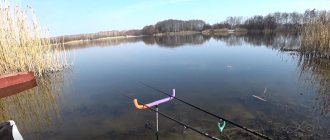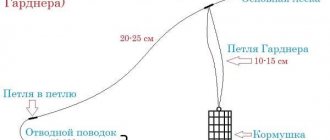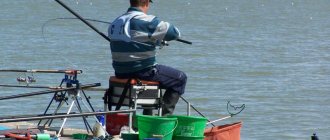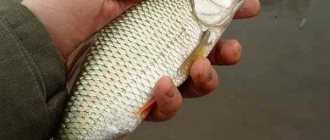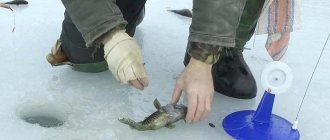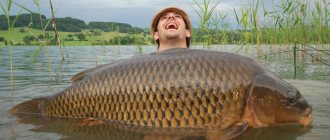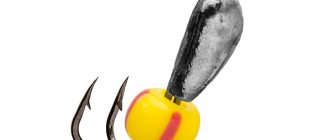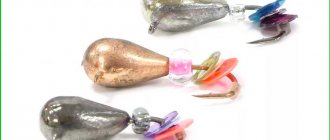Catching bream in April on a feeder
The long-awaited time of ice melting and warming opens up new horizons for fishermen. So, fishing for bream in April on a feeder is very effective, because all the fish are moving away from winter torpor and active fish biting begins in preparation for the upcoming spawning.
Bream is a bottom-dwelling fish that feeds mainly on larvae, that is, most of its food is of animal origin. With a good food supply, bream grows quickly.
Found in most rivers, such as the Don and Volga; in lakes, artificial ponds with running water (Tsimlyansk Reservoir). It feeds at dawn and at night in the shallows, near the shore.
Tackle for bream
We have sorted out almost all the nuances that usually arise when catching bream. But there was only one question left: what kind of tackle is better to fish with, a donk or a float. Well, it depends on some factors, if you are going to fish in some pool or bay, where the current is very weak or completely fades, then you can quite successfully fish with a float rod. A weak current will also not hurt you if you lower the bait to the very bottom. The main thing is that the bait is not dragged, it must be motionless, because bream does not take the bait if it is dragged by the current. But it is not always possible to find bream in places where there is no current or there is one, but it is weak. Often bream sites are found in places where the current is very strong and the equipment is constantly being carried away, in which case you have no chance of catching bream on a float rod. Here it is worth using bottom equipment, and if the current is very strong, then try to choose a heavier sinker so that the bait also remains in the place where you throw it. Even if it crawls slowly along the bottom, the bream won’t take it either.
Where to catch bream on a feeder in April
His favorite places are silted, clay bottom, deep parts of the reservoir. It is easy to find by observing the surface of the river a little in calm weather. The flock can be seen playing. So, you can start fishing. The easiest way to catch it is to fish at night, close to where the fish live. Usually it does not travel long distances from its permanent location.
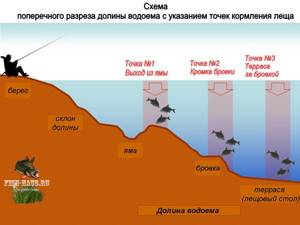
If you have a steep yar in mind, next to which there is a calm current and quite deep, as well as a flooded tree, you need to try it. An exit from holes, a deep fairway, next to a dam or dams, a little trash - all this attracts him.
Selection of gear
Rod
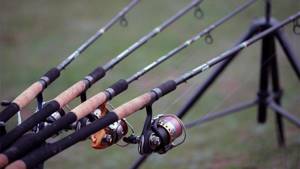
The choice depends on the fishing location. On small lakes and rivers with moderate currents, the casting distance of the tackle is short, as is the probability of catching large fish, so you can choose picker rods up to 3 m or light feeders 3.5 m. Larger reservoirs - medium class up to 4 m. Large rivers and lakes – heavy and extra heavy over 4 m.
- Pickers.
- length 2.1 – 3 m;
test 30-40 g.
- Medium.
- length 2.4-3.9 m;
test 40-60 g.
- Heavy.
- length 3-4.5 m;
test 60-120 g.
- Extra Heavy.
- length up to 3.6 -5.2 m;
test – more than 120 g.
Lightweight rods for catching not too heavy fish at a close distance from the shore up to 30 m in still water and in weak currents.
Rods with feeder weights of 30-50 grams for feeder fishing on medium-sized lakes and slow-flowing rivers.
Feeders for reservoirs with calm water and for rivers with slow and medium flow.
Designed for casting heavy feeders to maximum distances on large lakes and rivers with calm water and fast currents.
Test
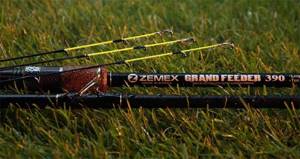
The choice depends on the weight of the gear being cast and the expected weight of the fish.
Strong currents in normal times intensify in early spring, which indicates the need to use heavy feeders of 130-150 g with a corresponding feeder test of 100-160 Extra Heavy class.
Since maximum casting is not required in early spring, you can choose a short stick that meets this class. But sometimes the swampiness of the banks due to the river flood does not allow one to approach the bed of the reservoir, in which case it is necessary to take into account the additional distance when casting.
Test in Lb
Often the feeder test is determined in pounds Lb based on the breaking load of the line, in which case the diameter of the monofilament line and leader can be immediately determined.
| Feeder test, lb | Main line diameter, mm | Lead line diameter, mm |
| 10-12 oz | .06-.07 | |
| 1 | 0.08 | |
| 2 | 0.14 | 0.10-0.12 |
| 3 | 0.16 | 0.12-0.14 |
| 4 | 0.18 | 0.14-0.16 |
| 5 | 0.20 | 0.16-0.18 |
| 6 | 0.22 | 0.18-0.20 |
| 7 | 0.23 | 0.19-0.21 |
| 8 | 0.25 | 0.21-0.23 |
| 10 | 0.28 | 0.23-0.24 |
| 12 | 0.30 | 0.25-0.26 |
Expert opinion
Knipovich Nikolai Mikhailovich
Zoologist, hydrobiologist. I am interested in fishing at a professional level.
Attention! 1Lb (pound) = 0.453 kg. 1 oz (ounce) = 28.35 g.
Tip test
The feeder usually comes with 3-4 colored interchangeable tips with various tests that indicate not the load, but the degree of softness of the tip, and the value is indicated in ounces.
- Green (soft) - for standing water and slow flow.
- Yellow (medium) - for standing water and medium flow.
- Red (hard) - for strong currents.
Rod material
- Fiberglass is a cheap and heavy option. For long casting and good sensitivity, it is better to choose carbon fiber.
- Carbon fiber rods are lightweight and have good sensitivity, but are not resistant to shock loads.
- Composite material. In terms of their properties, rods made from this material are between carbon fiber and fiberglass rods.
Build
- Slow action is suitable for thin lines and careful, controlled fishing.
- A fast action allows you to speed up the fishing process, but poorly controls the movement of the fish.
- Medium. Medium is just that - between fast and slow.
Coil
The table shows what size reel should be chosen for fishing lines of different diameters.
| Reel size, mm (Shimano) | Braid, lb | Monofilament line |
| 2000 | 4-6 | 0.12-0.16 |
| 2500 | 6-8 | 0.16-0.2 |
| 3000 | 8-10 | 0.2-0.24 |
| 4000 | 10-12 | 0.24-0.28 |
| 5000 | 12-14 | 0.28-0.32 |
In late spring, you can use match reels with a gear ratio of 5:1÷5.2:1.
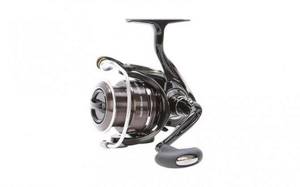
In early spring, it is better to give preference to power carp reels with a gear ratio of 4.8:1÷4.9:1.
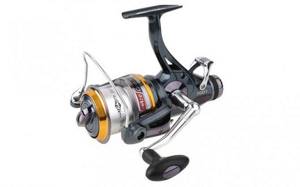
Coil size. The spinning reel is matched to the fishing rod. The most popular size is 3000-5000. For heavy and extra heavy feeders, size 6000 coils are used.
Friction brake. There is no big difference between the front and rear clutches, but many feeders still prefer the rear clutch. For carp fishing, it is advisable to have a reel with a baitrunner.
Spool. A large diameter low profile spool is preferable for feeder fishing. The number of bearings is at least 4.
fishing line
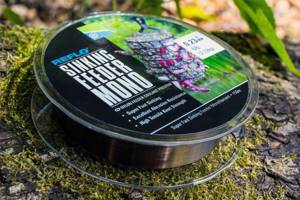
At close distances, the best option is a monofilament tensile fishing line of 0.16-0.2 mm. At a distance of 40 meters, the stretchability, which serves to compensate for fish jerks, reduces the sensitivity of the tackle and does not provide a sharp hook. At long distances, you can use monofilament fishing line and a braided shock leader or 0.12-0.14 mm braided line with feeder rubber.
Leashes
In early spring, water transparency in lakes is much higher than in rivers.
It is better to make a leash that performs a camouflage function from fluorocarbon fishing line.
The safety function of the leash is carried out by using a fishing line with a 10-20% lower breaking load than the main one.
In still water, leashes 0.4-0.45 m long are used. In currents - 0.6-0.7 m.
Hooks
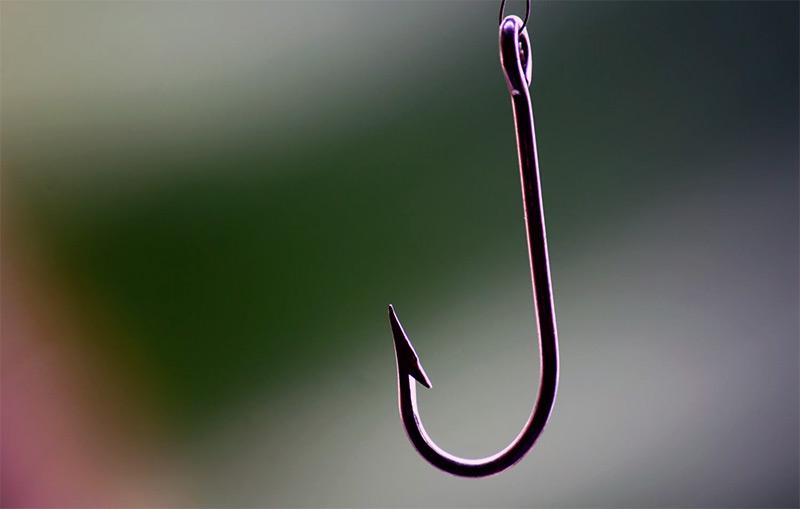
Feeders have long decided on the choice of branded hook models:
- GAMAKATSU.
- LS 3524F - thin wire hooks for animal bait;
- LS-1010B - hook with a spatula made of medium-thick wire for animal bait;
- LS-3614 F is a high-strength hook made of thick wire for catching large active fish.
- OWNER.
- 50001— made of thin wire for baiting with bloodworms and maggots;
- 50188 — hooks made of thick wire with a shortened shank for baits of plant origin;
- 50344 — high-strength hooks for trophy fishing.
- MUSTAD.
- Nickel Bream Feeder 60332N and Black Nickel Medium Feeder 60126BLN/LP280 - thin wire hooks for baiting small animals;
- Feeder 60332BR - high strength hooks.
Feeders
The main requirement for the feeder is to slowly wash out the food for at least 10 minutes. For early spring fishing, feeders with sliding mounting are used, which is optimal for cautious fish.
For standing water
Large-mesh plastic feeders are used, since there is no stream of water that can wash the food out of the feeder. The shape can be round or square. Feeders weigh from 30 g for standing water.
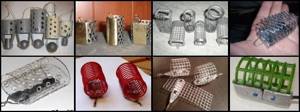
Recently, flat-method feeders have become widespread, which are a platform with loading on a flat bottom and several stiffening ribs. Such feeders require a special mold to compact the feed. Special food is also used - dusty to form a bait cloud.
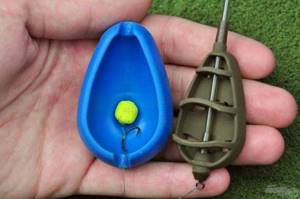
On the current
Fine-mesh wire feeders of round or square shape are used. For weak currents, feeders weighing 60-80 g are used, for strong currents - 80-150 g.
For early spring, long casting is not required, and only in the second half of May do most fish switch to summer feeding mode and move away from the shores. Then you will need feeders for long-distance casting with an offset weight at the end in the form of a bullet, capable of flying over long distances from 50 m.
Where to look for bream in April
Most often, the location relative to the shore depends on the weather. The cooler it is, the farther from the coast it moves.
Often during the day it can be seen in the shallows far from the shore, because the water in such places warms up better.
At night, on the contrary, the water cools down more slowly in the depressions, so the bream rolls up and stands there.
Morning bream fishing on a feeder in April can be the most successful. On a sunny morning it approaches the shore and is at a depth of about one and a half or two meters. After which, as the water warms up, it moves back to the shallows.
In the evening it approaches coastal areas covered with algae.
Finding a fishing spot
Before spawning, bream is in shallow water, not far from the coastline. Reeds and snags are favorite places for bream. That is, in early April, it fattens, near the shore, where there is more food, and after spawning it goes to depth.
And here the question arises for all sensible people: how to catch bream with a float rod if it is far from the shore? In this case, it is more comfortable and practical to catch bream on the bottom. This simple gear allows you to fish at a distance of 25-35 meters from the shore. In addition, it is convenient for fishing during strong winds.
There are many varieties of donkey, but the simplest and most effective of them consists of a rod 3-3.5 meters long and a feeder. But the length can vary depending on the fishing distance - the longer the rod, the further you can throw the feeder with bait.
Spring bream fishing on a feeder in April
If you want to catch a large specimen of bream, then you need to be patient and properly prepare the tackle and installation of equipment. The time for fishing is day or late evening. You won't need a rigid rod. The length of the feeder blank - 3-4 meters will be sufficient, because at this time it comes closer to the shore.
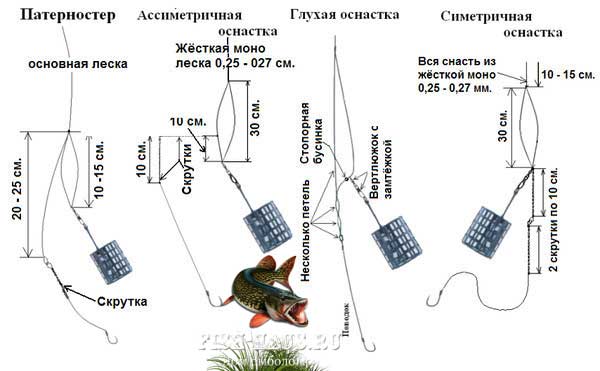
Feeder gear for catching bream in April:
- The length of the rod must be at least 3.6 m with a test weight of up to 90 g. When fishing on a river, you can take a longer rod.
- It is preferable to use a reel in the range from 3000 to 4000. It will also not be amiss, especially when fishing at night, to use reels with a baitrunner.
- The choice of fishing line depends on the recommendations on the rod itself. Moreover, the diameter of the leash must be at least 0.12 mm. Monofilament can be used as the main thread in still water, or braided thread for currents.
- The size, weight and shape of the feeder is determined by the fishing location. For a standing pond, round, oval, rectangular models made of metal or plastic weighing 40-60 g are suitable. To fish in the current, rectangular or triangular shaped metal feeders weighing 60-100 g are required.
- The length of the leash is not so important; sometimes it can reach 1 meter with a weak bite. But you should start with a leash 30-50 cm long.
- The choice of hook directly depends on the bait used, as well as the size of the trophy. For bream, the optimal size would be No. 8-14.
- Of the great variety of feeder equipment, the asymmetrical loop and paternoster have proven themselves the best.
Equipment for bream

As for the equipment, bream is very sensitive and shy, these indicators speak for themselves. Therefore, the equipment should not be rough, the fishing line should be set as thin as possible, but do not forget that the fishing line, despite its thinness, should also be quite strong. The best option would be to use a braided fishing line; it is both thin and extremely durable, designed for catching serious fish. Do not forget that bream is a very serious and strong fighter; it resists with dignity. You should use small hooks, since bream’s mouth is not as large as, for example, perch’s. The bream should calmly swallow the hook so that nothing interferes with it. If you fish with a float rod, then use a light, well-sensitive float. It is better to place the sinker movable so that it can easily move up and down the line. This is necessary so that the resistance is less, the sinker also provides a little resistance, but it is small for a person, but for a fish it is simply enormous.
Video
Fishing for bream in April with Normund video
On the river, spring feeder fishing in April with Normunds Grabovskis in Estonia on the Emma River.
Catching bream on a feeder in spring video
Catching bream on a feeder in the spring is very interesting and exciting. Fishing in general in the spring is difficult in itself; you need to find the key to the fish and not make mistakes in the bait. Fishing in the spring of the 2106 season, video report on catching bream on the feeder. Catching bream on a feeder was our goal for this spring fishing on the Neva River. The morning fog did not give us the opportunity to properly feed the point with bait to attract bream, but despite this, the bream was biting perfectly in the earliest spring morning. And what could be better than fishing in the spring and the long-awaited bites on the feeder. Only by lunchtime the bite subsided, when the sun rose high and warmed the air. This was the second spring fishing trip this season. And I was very pleased with her!
Bait for bream
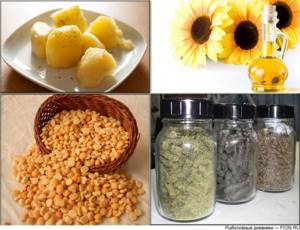
As for bait, it is impossible to say exactly what the bream will bite on today or tomorrow. The tastes of bream change very often in the spring, so the fisherman’s assortment should be extremely rich. You must have both dung worms and rain crawlers, you can also take bloodworms with maggots with you. But the most important delicacy of bream is lard; the fisherman should always have it. Not all anglers know that bream can be quite successfully caught using small pieces of lard, but this fact has long been proven by more experienced anglers. You can also take green peas with you, usually the fish don’t take to plant baits at all in the spring, but sometimes they find something on bream and they can very actively take on green peas. This, of course, is a rarity, but who knows, maybe this rarity will happen today.
Groundbait and bait
The main emphasis in baits is on animal baits or at least with a similar smell (when fishing with flat boilies or pelets). At first, at the beginning of the spill - thin leashes on the feeder, a couple of bloodworms or one maggot on a small hook. With the increase in water temperature and fish activity in April, we enlarge the baits and, accordingly, the hooks. Even roaches will do better on a bunch of small worms or a few maggots. Bloodworms also work in April, but bleak may not allow you to use them.
With further warming, the following can work on the feeder:
- Corn;
- Pearl barley;
- Star pasta;
- Steamed wheat.
- For the flat method - boilies and pellets of krill, halibut, shrimp, halibut and other similar ones.
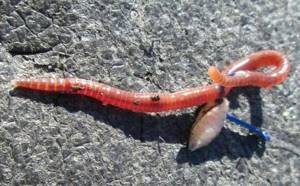
The consistency of feeder bait in April on the river is stickier than for stagnant bays. However, as always, the food should not lie on the bottom in a sticky lump, but should be destroyed in the stream. Aroma – also animal or herbal, not fruity-sweet:
- Anise;
- Dill;
- Fennel;
- Coriander;
- Garlic;
- Animal aromas – worm, bloodworm, maggot, halibut, krill, shrimp, squid.
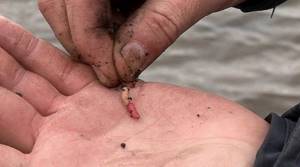
Active feeder fishing at the end of April will forgive mistakes in preparing bait, especially during the current. At the beginning of the month, for passive fish in cold water, we feed them carefully and little, with the addition of a live component, bloodworms or maggots, without using powerful flavorings.
You can use both purchased and homemade mixtures based on breadcrumbs, cake, pork feed in granules (ground), rolled oats. In reservoirs that are not pressed by fishermen, fish prefer natural aromatics rather than colorful chemicals.
For active fishing in April, you can use mixtures based on millet or pea porridge in warmer water, and it is difficult to overfeed actively moving fish.
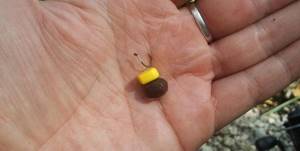
Feeder in flood
- The main criterion for fish activity in April is water temperature. In some rivers the ice breaks early, and the water is cold, no more than 5-6 degrees.
- Fish are just beginning to become active in April, and you need to catch them with a feeder according to the March laws of thin equipment and careful feeding. The main objects for the feeder are roach, ide, bream, fisherman, crucian carp (in the south).
- As the temperature rises to 8-10 degrees in April, crucian carp and other fish begin to wake up. At this time, the rivers are usually already cleared of ice, and fish begin to migrate. The usual places for a feeder in large rivers beyond the edges may not work, since the fish go into shallow bays to the reeds - it’s warmer there.
- Spawning adult fish from large reservoirs in April go to tributaries or to the upper part of the drainage, feeding along the way. Therefore, the most promising places for a feeder are small and medium-sized rivers. Feeder fishing in April is unpredictable.
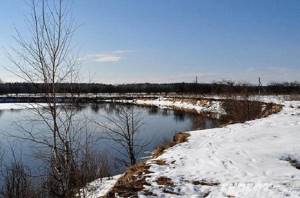
Yesterday there was no bite at all - today a flock of bream, crucian carp or small fish going upstream is feeding in the same place. Therefore, there is no single recipe for finding a catchable place for a feeder. There is only one tendency - you shouldn’t go into deep holes with a feeder; it’s better to look in shallow bays, flooded meadows or small rivers, completely shallow or at depths of 2-3 meters.
- In April, during the current, sometimes it is not the classic feeder tactics with feeding that works better, but search fishing and interval stretching of the feeder with a leash to find the points where the fish are moving. In this case, the point does not feed immediately.
- The feeder is cast (you can even use a sinker rather than a feeder) with bait for about 10 minutes, then pulled closer. If we find a point with bites, we clip the tackle and feed it, as in a standard feeder. We also check the places to the left and to the right.
- In a strong current, catching with a feeder on the underside can work, when the equipment twitches, and with each such movement it is carried further. This is convenient to do from a cape or along the deep-water shore.

Small rivers
The key is to strategically find the fish. If it doesn’t bite at all, you need to change the place. With the rise of water in small rivers in April, a lot of different fish from large reservoirs enter them. The fish strives upward, feeding as they go, stopping briefly in convenient places, day or night.
In April you can catch anyone with a feeder - bream, anadromous crucian carp, ide, small fish. The main thing is not to try to fish in deep holes - now the fish need warmth, and it will stick to shallow places and go through the pools from above. The best places for feeder fishing:
- Reverse flow.
- Boundary between calm water and currents in shallow bays.
- Reed edge with shallow depths.
- Depths of 1-1.5 meters immediately drop off under the shore with overhanging grass or reeds.
- Separate shelters are slopes, capes, lying trees or snags.
- Uniform watering with current and depths of no more than 3 meters.
- Water meadows and shrubs, clearings between them.
- The main channel of the river with a shallow depth - we fish as usual, behind the edge and on the tables.
Large rivers and reservoirs
In the usual places for summer fishing for bream, silver bream and carp with a feeder, at depths of over 4 meters behind the edges there may not be a bite. It is better to move to narrower and shallower areas upstream, or to shallow bays with grass for crucian carp. At the peak of the flood, the current in large rivers is very strong, carrying debris and sticks, making it not comfortable to fish with a feeder. It is better to return to your usual places when the water subsides in May, when the fish begin to return there.
The principle for the feeder is the same - the main thing is to find cool places. Moreover, their performance is difficult to predict. Today there is migratory fish here, but tomorrow there won’t be. A feeder on a river in April is more convenient to use on medium-sized rivers and their small tributaries. Here you can also fish on the riverbed, if not too deep, counting on passing schools. In April you need to listen to the “fishing radio” in this particular area.
“The bream has gone” or “the fish is descending” are signals to immediately go to the reservoir; in a week it may already be too late. When crucian carp comes in April, you can catch it everywhere and with anything, usually in shallows or in flooded bushes. A crucian carp walking along the riverbed may not feed at all, but if it stops and climbs into the thickets, don’t yawn – the main thing is to choose the right bait. Usually it is a worm, maggot or corn.
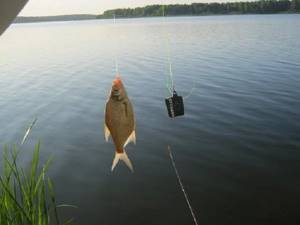
Ponds
Closed ponds are freed from ice later, and there is no flood as such. The water becomes cloudy and its level rises slightly. Here fishing in April depends on the degree of warming up of the reservoir. We try to fish on the feeder on clear, sunny days, using classic rigs or the flat method. Groundbaits and bait in April - animal or pepper aromatics. These can be boilies and pellets with aromas:
- Monster crab;
- Halibut;
- Krill;
- Various spices.
Corn may not work yet; it is better to fish with meat and fish pellets, boilies or the usual worm with maggots. Any change in weather, wind, rain - and the weak bite disappears. Naturally, we fish in shallow, warm bays near the reeds, especially if they begin to sprout. Cat food with a fishy or meaty smell sometimes works well for April crucian carp, bream or carp. It can also be crushed and added to the feeder bait.

Some fishing features
Well, on the other hand, you won’t be constantly running around with a thermometer and measuring the temperature “overboard”! So, for example, Muscovites fishermen begin to catch this fish quite early. Almost at the beginning or mid-April, a bite already occurs on the Moscow Canal, but it can be quite short-lived. But when bream starts biting in the spring in the Urals, May may already be in full swing. It all depends on the climatic conditions and the location of the reservoir designated for fishing. So, when bream begins to bite in the spring in St. Petersburg, in the Moscow region the bite may already stop and spawning begin.
Dependence on temperature and wind
Crucian carp is a heat-loving fish, and in the spring its dependence on water temperature is very pronounced. Having found a new promising body of water or having arrived at a well-known lake, I always spend my first spring fishing trips in the shallowest areas, where the depth does not exceed two meters (photo 1). This is where the crucian carp first goes in search of food. It is very good if the hook with the nozzle is located near reed thickets or islands of overwintered underwater vegetation. There are always a lot of underwater crustaceans and insect larvae, which the crucian carp feeds on in the first spring months.
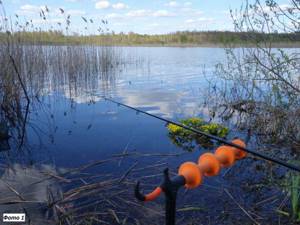
In addition, in spring it is very important to take into account the direction of the wind. It has been noticed that in April crucian carp are always better caught on the leeward side. Apparently, the wind not only enriches the water with oxygen and brings additional food to the leeward areas, but also moves warm air masses, which further warm the water. This process is known as spring water circulation.
As a result of the action of the wind, as well as the difference in day and night temperatures, movement of water masses occurs: cold and warm water gradually mix with each other - and the fish here begin to feed more actively.
If there is a cold snap on the eve of fishing, I temporarily leave the shallow water areas and switch to fishing the dumps bordering the shallow water in depth. In general, in the spring it is very important not to get hung up on any one area, but always try to catch the maximum possible number of promising points. The fish are also actively moving.
